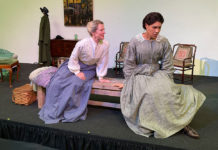Are you thinking about your yard, what you want to change, that
lawn you’re finally going to demolish, or the invasive or tired
ornamental shrubs that you’ll replace with California native
plants?
If you are one of those folks who just cannot imagine giving up
your lawn, but are tired of comments by well-meaning friends or
family, and dread the upcoming season of mowing, fertilizing,
pesticiding, or fungiciding your lawn, you could look at removing
MOST of the lawn. You could leave a patch large enough to sit to
watch clouds or just doze, or a place for your kids to wrestle, or
for your dog to spread out on a warm summer’s day. There is really
no advantage to a huge lawn, only disadvantages. A huge tract of
grass is a throwback to our past. It is not appropriate to the
reality of California’s, even the world’s, growing water shortages
or supply.
Worst of all, in these times of loss of wildlife habitat, lawns
support no birds or other wildlife. A yard full of herbs, salvias,
ceanothus, manzanitas, un-frilly zinnias, milkweeds, toyons, monkey
flowers…there is no end to the beauty of a garden planted for
wildlife. If you have a strip of grass in front of your house, or
between the street and the sidewalk, dig it up and plant it with a
low-water shrub such as Salvia ‘Bee’s Bliss.’ Interplant it with
our lovely native iris, Iris douglasiana. Iris means rainbow in
Greek, and you can find this iris in a rainbow of colors. Barberry
(Berberis sp.), a shrubby little perennial that requires little
water is a good ground cover, perhaps interplanted with CA poppies
and our native yarrows. Most natives need little pruning, little
water, little maintenance, certainly no pesticides, herbicides or
fungicides. Come on, let’s put the chemical companies out of
business!
Our native currants (Ribes sp.) are wonderful habitat shrubs.
Their maple-like leaves are fragrant and a pretty green and are
winter deciduous. The dense clusters of rose-red flowers bloom up
in late winter and are loved by hummingbirds. They are easy to grow
and the berries will be attractive to birds. Full sun to light
shade and plenty of water initially will suit them. After they are
rooted in, you can taper the water off to occasional deep
waterings. Ribes sanguineum var. glutinosum, the pink-flowering
currant, is a popular species.
Please support the CA Native Plant Society. Not only can you
attend free monthly meetings, you will have access to a group of
knowledgeable plant people, and wonderful field trips. Their
journal, “Fremontia” and bulletin are mailed out quarterly and
their newsletters monthly. They offer books and seeds and an annual
plant sale. All this for only $25 to $45 a year. You can’t lose.
Please contact Gary Hundt at 542-4972 or at: gh****@gm***.com to sign up
Ever wanted to learn how a “key” works in a plant i.d. book or
how to collect and identify a plant you see out in the field? Lynn
Houser, the president of our local Milo Baker chapter, will present
a program on just that subject on Tuesday, March 9. Meetings start
at 7:30 pm and are held at the Luther Burbank Art & Garden
Center at 2050 Yulupa Avenue in Santa Rosa. Free refreshments and
books for sale! Call April Owens at 528-3387 or ap***********@ya***.com if you
need more information.
Write me if you have questions or comments: jo*******@co*****.net.
48.9
F
Healdsburg
April 19, 2025







